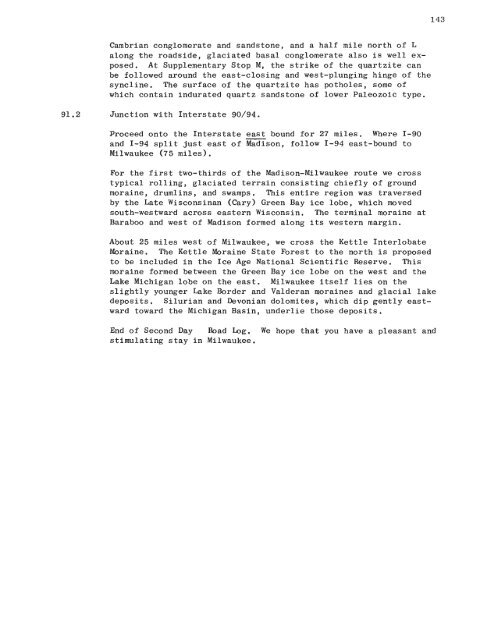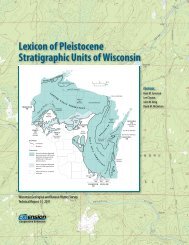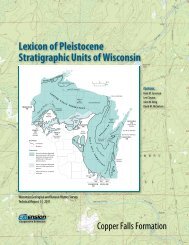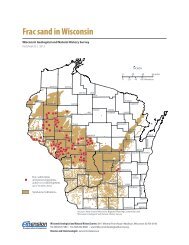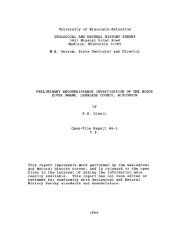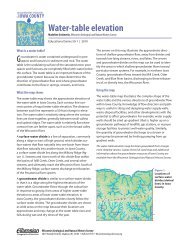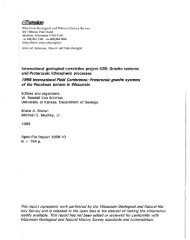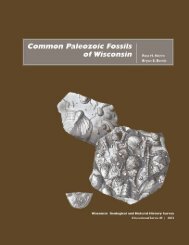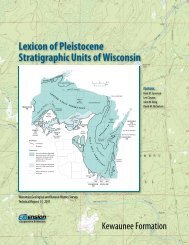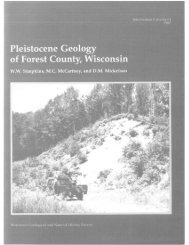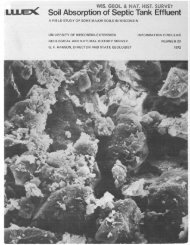IC14. Geology of the Baraboo District, Wisconsin: A description and ...
IC14. Geology of the Baraboo District, Wisconsin: A description and ...
IC14. Geology of the Baraboo District, Wisconsin: A description and ...
Create successful ePaper yourself
Turn your PDF publications into a flip-book with our unique Google optimized e-Paper software.
Cambrian conglomerate <strong>and</strong> s<strong>and</strong>stone, <strong>and</strong> a half mile north <strong>of</strong> L<br />
along <strong>the</strong> roadside, glaciated basal conglomerate also is well ex-<br />
posed. At Supplementary Stop M, <strong>the</strong> strike <strong>of</strong> <strong>the</strong> quartzite can<br />
be followed around <strong>the</strong> east-closing <strong>and</strong> west-plunging hinge <strong>of</strong> <strong>the</strong><br />
syncline. The surface <strong>of</strong> <strong>the</strong> quartzite has potholes, some <strong>of</strong><br />
which contain indurated quartz s<strong>and</strong>stone <strong>of</strong> lower Paleozoic type.<br />
91.2 Junction with Interstate 90/94.<br />
Proceed onto <strong>the</strong> Interstate - east bound for 27 miles. Where 1-90<br />
<strong>and</strong> 1-94 split just east <strong>of</strong> Madison, follow 1-94 east-bound to<br />
Milwaukee (75 miles).<br />
For <strong>the</strong> first two-thirds <strong>of</strong> <strong>the</strong> Madison-Milwaukee route we cross<br />
typical rolling, glaciated terrain consisting chiefly <strong>of</strong> ground<br />
moraine, drumlins, <strong>and</strong> swamps. This entire region was traversed<br />
by <strong>the</strong> Late <strong>Wisconsin</strong>an (Cary) Green Bay ice lobe, which moved<br />
south-westward across eastern <strong>Wisconsin</strong>. The terminal moraine at<br />
<strong>Baraboo</strong> <strong>and</strong> west <strong>of</strong> Madison formed along its western margin.<br />
About 25 miles west <strong>of</strong> Milwaukee, we cross <strong>the</strong> Kettle Interlobate<br />
Moraine. The Kettle Moraine State Forest to <strong>the</strong> north is proposed<br />
to be included in <strong>the</strong> Ice Age National Scientific Reserve. This<br />
moraine formed between <strong>the</strong> Green Bay ice lobe on <strong>the</strong> west <strong>and</strong> <strong>the</strong><br />
Lake Michigan lobe on <strong>the</strong> east. Milwaukee itself lies on <strong>the</strong><br />
slightly younger Lake Border <strong>and</strong> Valderan moraines <strong>and</strong> glacial lake<br />
deposits. Silurian <strong>and</strong> Devonian dolomites, which dip gently east-<br />
ward toward <strong>the</strong> Michigan Basin, underlie those deposits.<br />
End <strong>of</strong> Second Day Road Log. We hope that you have a pleasant <strong>and</strong><br />
stimulating stay in Milwaukee.


